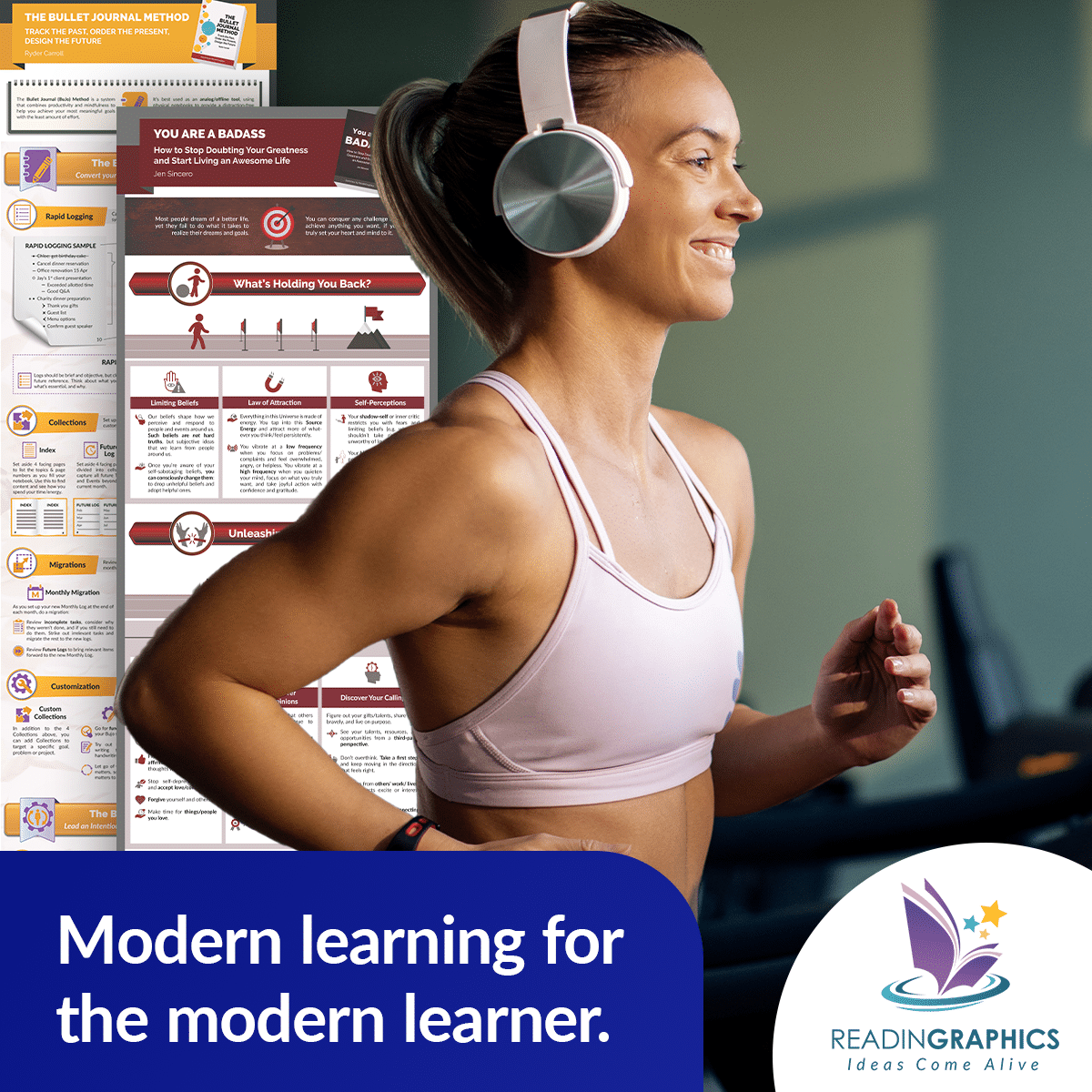By: readingraphics.com
Grasping complex ideas or developing new skills can be a daunting task for adult learners, especially when time is limited. Visual learning offers a practical solution, making it easier to absorb and retain information by engaging with content in a more accessible way. Whether through infographics, diagrams, or other visual aids, these tools have become valuable resources for enhancing the learning experience in adult education.
Visual learning goes beyond just saving time—it enhances the effectiveness of learning itself. Studies show that the brain processes visuals faster and more efficiently than text, leading to improved retention and understanding of information.
This is especially valuable for adults juggling various responsibilities—work, family, personal growth—who often find it challenging to engage with lengthy, text-heavy materials. By simplifying complex ideas, visuals provide a more direct, accessible route to learning, cutting through distractions and making it easier to grasp key concepts.
Visual learning has become a tool in making lifelong learning more accessible and engaging. One example is ReadinGraphics, which has placed visual learning at the core of its mission. The platform is unique in offering comprehensive, infographic-based book summaries that distill entire books into easy-to-digest formats. According to Angela Lam, CEO of ReadinGraphics, “Research shows that people retain 65% of what they learn through visuals, compared to just 10% from text alone. Infographics provide a visual roadmap that helps learners connect key ideas within a book. When paired with detailed text and audio summaries, this approach accelerates learning and deepens understanding, making it easier to apply insights in real-world contexts
“People retain 65% of what they learn with visuals, compared to just 10% from text alone,” says Angela Lam, CEO of ReadinGraphics. “Infographics provide a visual roadmap that connects ideas within a book. Combined with the detailed insights from text and audio summaries, they significantly accelerate learning while maintaining depth, making it easier to apply knowledge in real-world situations.”

The Cognitive Benefits of Visual Learning
At the core of visual learning is its ability to align with the way the brain naturally processes information. Studies show that humans are wired to respond to images—our brains are more likely to store and recall information when it’s delivered visually. In fact, 65% of the population are now visual learners. According to Training Magazine, 88% of large companies, 77% of mid-sized companies, and 64% of small companies were already using video training prior to the pandemic––and roughly 63% of corporations already relied on self-paced virtual elearning to train individuals and teams.
This cognitive advantage can be especially useful in adult education, where learners may have to absorb large amounts of information in a short period of time. Visual aids like charts, infographics, and diagrams condense information into its essential components. By removing unnecessary details and focusing on the key points, these tools can simplify complex topics and make them easier to understand.
For adult learners, who often need to quickly digest and apply new knowledge, this efficiency is invaluable. Instead of wading through dense text, learners can engage with visual content that presents the same material in a more structured and accessible way.
Retention and Recall: Why Visuals Work
Memory retention is another area where visual learning proves its worth. Adults often find it difficult to remember information presented only in text. When visuals are used alongside written content, learners are better able to form mental connections that aid in recall. These visual cues help organize information in the brain, making it easier to retrieve later on.
For example, a complex idea that might be difficult to retain through text alone can be made more memorable with the addition of a simple visual representation. Diagrams and flowcharts, for instance, break down processes into individual steps that are easy to visualize, enhancing long-term retention. Visual learning doesn’t just simplify information—it helps learners retain it more effectively, improving their ability to recall important concepts.
“Learning should be dynamic, engaging, colorful, and fun—whether you’re 6 or 60,” says Lam. “Our brains naturally prefer images over text, so why not use visuals to make complex ideas easier to understand, remember, and apply?”
Practical Applications for Professional Development
In the professional world, staying relevant often requires ongoing education, but the demands of daily work can make it challenging to find time for learning new skills or staying up-to-date on industry trends. Visual learning offers a practical solution by breaking down complex concepts into formats that are quick to absorb and easy to apply.
Specific elements like visual hierarchies, color-coding, and mind-mapping can transform dense information into more digestible pieces. For instance, leadership development—covering areas like management strategies, decision-making, and team dynamics—can be presented through visual explanations that allow professionals to quickly grasp key insights. In fast-paced industries, where being ahead of trends is crucial, visuals not only simplify learning but also make it easier to recall and apply what’s been learned.
“Visuals don’t just make learning faster; they make it stick,” says Angela Lam, CEO of ReadinGraphics. “When you can easily recall and connect ideas, you can also generate creative solutions more effortlessly and innovate faster.”
By integrating these visual tools into their professional development routines, individuals can sharpen their skills without a major time commitment. Color-coded frameworks help prioritize information, while mind-mapping fosters connections between concepts. As a result, professionals experience faster learning cycles and are able to apply new knowledge more immediately in the workplace.
The Role of Visual Learning in Lifelong Education
Lifelong learning isn’t just about acquiring knowledge for a specific career or professional goal. For many adults, the pursuit of education extends into personal growth, hobbies, and adapting to life changes. Visual learning plays a key role in making this ongoing education accessible, especially for those who may not have the time to commit to traditional, text-heavy study methods.
Whether it’s learning a new language, mastering a hobby, or keeping up with evolving technology, visual aids make it easier to engage with new topics. Learners can explore subjects that interest them in a more relaxed and manageable way, allowing for a deeper understanding without the pressure of extensive study. Visual learning encourages curiosity by presenting information in a way that feels more approachable, making it easier to dive into new areas of knowledge.
This is especially beneficial for adults who may have experienced difficulties with traditional learning environments in the past. Visuals help break down the barriers to learning, offering an alternative that is often more engaging and inclusive.
By making education feel less overwhelming, visual learning opens the door for more people to continue their educational journeys, regardless of their previous experiences with formal education.
Enhancing Corporate and Adult Education Programs
As adult education programs grow in importance, many institutions and organizations are recognizing the value of incorporating visual learning tools into their curricula. From corporate training to certification courses, visual aids are proving to be effective in making learning more engaging and interactive. In a corporate setting, visual learning can be especially useful for breaking down complex business models, operational workflows, or technical processes.
Incorporating visuals into adult education programs also helps to accommodate different learning styles. Not all learners absorb information in the same way—some may thrive with text, while others prefer visual or auditory input. By offering a range of learning formats, including visuals, programs can cater to a broader audience and improve overall learning outcomes.
For educators and trainers, using visuals isn’t just about simplifying content; it’s about creating an interactive learning experience that encourages participation and deeper understanding. Visuals allow learners to actively engage with the material, rather than passively receiving information, fostering a more dynamic and effective educational environment.
The Future of Learning: Embracing Visual Tools for Lifelong Success
Visual learning has become an essential tool in adult education and lifelong learning. By offering a faster, more accessible way to absorb and retain information, it bridges the gap between limited time and the need for continuous growth. Whether for professional development, personal enrichment, or simply staying informed, visual learning tools make education more efficient and effective.
As learning needs continue to evolve, visual aids like those created by ReadinGraphics will remain an invaluable source for adult learners to keep learning.
Published by: Holy Minoza

















